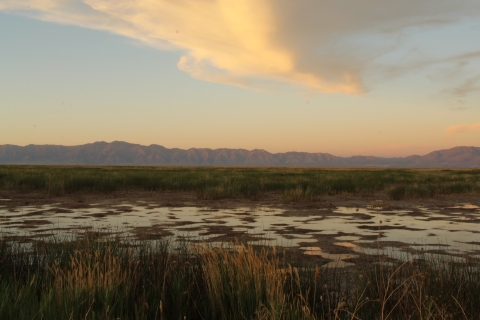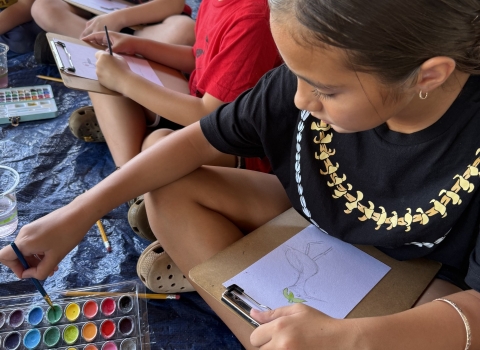Sandra Uecker is the USFWS Library’s latest Behind the Lens photographer who likes to relax by grabbing her camera and photographing wildlife. She uses photography in an official capacity as a facilities management coordinator for Refuges in the Mountain-Prairie Region where she takes pictures of real property assets, and she’s passionate about growing her skills as a wildlife photographer outside of work too. A digital SRL camera without a fixed lens was one of the best things Sandra has ever bought for herself. She says it is an affordable option that works well and allows her to experiment with various settings and evaluate and continue to grow in her skills. She says, “It’s exactly what I needed to catch the shutter bug again.” After a stressful day Sandra unwind by grabbing her camera and binoculars and watching wildlife. Even if she doesn’t find anything to photograph, Sandra says, “I am still happy I got out of the house and just observe what is around me. I think photography does that, it makes you think and observe the world in a different way.”
Sandra recently contributed many of her images to the U.S. Fish and Wildlife Service’s National Digital Library. The National Digital Library, managed by the USFWS Library, is the premier source for public domain wildlife images, and home to the pictures, documents, audio, and video that tell the story of the Service. Public domain imagery is free to use, reuse, and share in any capacity. The FWS Behind the Lens blog series highlights Service employees in the field who have contributed spectacular photography, with an eye toward reflecting the full mission of the Service.
One of Sandra’s favorite things about her work is exploring new areas and using photography to observe the world in a different way. She shares, “My camera travels with me and I am rarely without it. You never know when a great photo opportunity will arise.”
Sandra grew up in Denver, Colorado and although she lived in an urban neighborhood, there were plenty of opportunities to explore nature. She reflects, “At one end of the street was a creek filled with small darters and crayfish, and at the other end there was an empty lot with grasses and a makeshift tree house in a large cottonwood tree.” She and her family enjoyed outdoor adventures like fishing and camping in the mountains. In the summers, Sandra visited a lake cabin in Minnesota where she went fishing every day, read, and explored the area.
Sandra has seen her artistic skills for drawing and painting translate into photography. She remembers her art teachers who taught basics of art evaluation and appreciation. “Since photography is also an art, I can apply the same evaluation techniques to photographs. In high school art class, my teacher used a phrase that she nicknamed “TICO”, which helped us evaluate our art and others artwork. “TICO” stands for Technique, Idea, Contrast and Overall.” Just like drawing, there are many factors to consider when taking a photo, such as light, aperture, shutter speed, and background.
Sandra earned a bachelor’s in wildlife biology from Colorado State University and has dabbled in photography throughout the years. Her first job out of college was with the U.S. Fish and Wildlife Service as a biological technician at Arapaho National Wildlife Refuge in Colorado. At that time, biological technicians at that station did a little of everything. She completed waterfowl surveys, checked nesting structures for Canada geese, managed invasive species invasive species
An invasive species is any plant or animal that has spread or been introduced into a new area where they are, or could, cause harm to the environment, economy, or human, animal, or plant health. Their unwelcome presence can destroy ecosystems and cost millions of dollars.
Learn more about invasive species , and helped maintain the lands among other tasks. Most of her photos were taken using Kodochrome film and her dad’s 35-millimeter (mm) camera that he passed down to her. If it weren’t for the costly prices to print slides and photographs, she would’ve devoted even more time to this passion. Later, Sandra became a wildlife refuge manager and worked at Lake Andes National Wildlife Refuge Complex and Lake Andes and the Huron Wetland Management Districts.
There are a couple notable life events that reignited Sandra’s interest in wildlife photography. The first was her nephew’s graduation from high school. This was a memorable milestone for her family, and documenting her family is one of reasons she loves to pick up her camera. The second event was a photography class at a “Becoming an Outdoors Woman” workshop, which inspired and excited Sandra to get outside and capture peaceful moments in the wild. She has been an instructor for the workshop and has led many courses for the Service. “Another catalyst to the photography bug was the pandemic. All of the sudden I had a lot of time to devote to my two loves, birding and photography.”
After several years as a wildlife refuge manager, Sandra switched to a new job series in facilities management. She is currently the facilities management coordinator for the Refuges program in Mountain-Prairie Region in Huron, South Dakota. Sandra spends her time looking at manmade fixed assets, also known as real property, on National Wildlife Refuges (NWR) within the region for the National Wildlife Refuge System. She takes photos of these assets, things like buildings, levees, fences, water control structures to determine if there are safety issues or repairs or replacements needed. The photos provide visual documentation, and inspection work orders provide written documentation of maintenance deficiencies and needs of these properties. A perk of the job is traveling to many different national wildlife refuges and enjoying the beautiful landscapes and wildlife. She enjoys outreach and education for people of all ages and loves seeing someone get excited about wildlife and nature. She says, “The best part of my job is to getting to assist national wildlife refuges in the replacement or rehabilitation of their real property, which benefits the FWS staff and the public.”
Whenever Sandra travels to an inspection site, she always packs her DSLR camera and 600mm lens. After a day of taking pictures of buildings, signs, and other inanimate objects, she excitedly turns her lens to the birds and the beauty of the landscape around her. One memorable visit was to the Tewaukon National Wildlife Refuge in North Dakota where many beautiful warblers and songbirds were out and about. But right at sunset, she noticed a pair of Upland Sandpipers in a grassy field on the refuge, whistling and calling to each other, and then saw their newly hatched chicks; a perfect ending to the day.
Sandra has learned tips from fellow photographers in the Service that help her take better quality images, like using a longer lens for bird photography. She often documents wildlife sightings and records them in citizen science apps like iNaturalist and eBird, which help identify birds as well as gather wildlife observation data. Sandra also uses the app, Merlin, to identify birds by their song, a critical skill for spotting many birds in the field.
Many of the small shallow wetlands that surround where Sandra lives, and works are protected by U.S. Fish and Wildlife Service Wetland and Grassland Easements. She says, “I hope that by capturing on film the many wonders and beauty of the wetlands, plants, insects, and birds within refuges and management districts, I will inspire others to explore and preserve this incredible landscape.” Visit our National Digital Library to find thousands of public domain images. Brought to you by the USFWS Library, #FWSBehindTheLens, #WeAreUSFWS.










